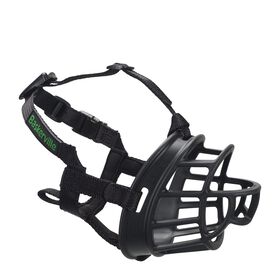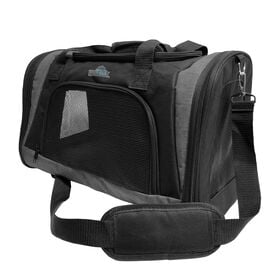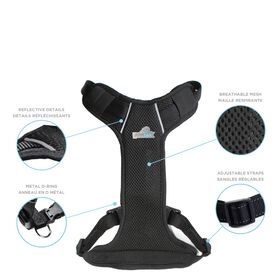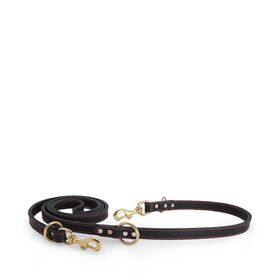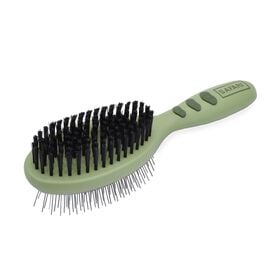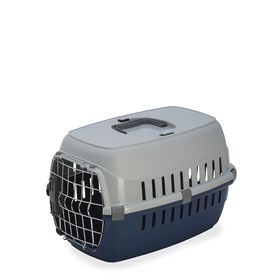
Riding the métro with your dog
Published April 19, 2023.

Isabelle Borremans
Dog trainer and behavior consultant
As part of a pilot project, the STM is now allowing you to travel with your dog in the métro, under certain conditions. Here are the necessary measures you need to take to ensure that the experience goes smoothly.
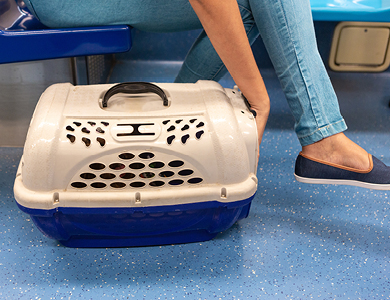
Use of a carrier cage
If you have a small dog and you prefer to carry it in your arms, remember that the dog must wear a muzzle. To avoid using a muzzle, you can also use a carrier cage made of plastic or fabric.
5 simple steps to get your dog used to being in a carrier cage
- Leave the carrier cage accessible at home to allow your dog to use it at its convenience with the cage door open.
- Place an accessory that your pet likes, such as a Kong filled with preserved food, a bone to gnaw on or a favourite toy, in the cage to keep the dog busy once you shut the cage door.
- Get you dog used to moving around in the cage by walking around the house with the cage when your dog is in it.You can slip treats into the cage while you’re moving around.
- Increase the time your dog spends inside the carrier cage.
- Make the cage comfortable by placing a blanket or light cushion in it, along with one of the dog’s favourite toys.
Basket muzzles are mandatory
A dog that is not in a carrier cage must wear a muzzle. Remember that it must be a “basket” type muzzle, regardless of the length of the trip. Cloth muzzles can be used only for a few minutes because they prevent dogs from panting (and therefore sweating). As you know, it can get pretty hot in the métro. Although many pet owners have a negative image of a muzzle, it’s important to remember that safety must be a priority for everyone.
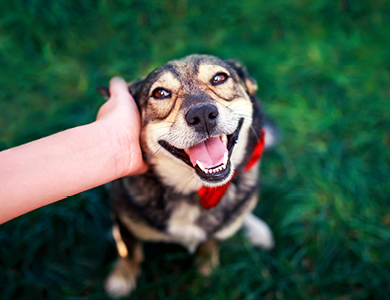
Getting your dog used to wearing a muzzle
If introduced the right way, a muzzle can easily become a positive item for your dog, much like when your dog sees its leash and gets excited about the prospect of going outside. Here’s how to do it:
- With a few treats in one hand and the muzzle in the other, reward the dog when it looks at the muzzle.
- Reward the dog when it touches the muzzle with its nose.
- Place a treat in the muzzle and allow the dog to retrieve it easily. Keep on rewarding the dog. The dog will simply keep its nose in the muzzle to get the food.
- Instead of placing the treat in the muzzle, place the treat next to the muzzle without giving it to the dog. Wait for the dog to place its nose in the muzzle before rewarding the dog.
- While the dog is eating a treat in the muzzle, slip the straps behind the dog’s head without tying them.
- Tie the straps without adjusting them and continue giving the dog treats.
- Leave the muzzle on the dog and encourage the dog to follow you to get it used to moving around while wearing the muzzle.
- Have the dog associate wearing the muzzle with positive activities, such as playing, walking and swimming.
- Gradually increase the duration of these steps. It’s normal for the dog to not want to wear the muzzle more than a minute or two at first. Take your time and move on to the next step only once the dog is comfortable.
- Your dog knows how much you care. Otherwise, you wouldn’t be as invested in making this an enjoyable experience.
A leash at all times
Mandatory measures include the use of a leash measuring no more than 4 feet long (1,25m or 49 in). Although you can choose a simple handle leash, I also like using a multi-function leash that you can tie around your waist and that allows you to decrease the part of the leash attached to your dog to 4 feet. Retractable leashes are prohibited, even if you lock the leash at 4 feet. You can also add a short handle leash that allows you to keep your dog close to you. Lastly, remember that a harness is mandatory for dogs that weigh 20 kg (44 lbs) or more.
Travelling by métro
If your dog is already comfortable travelling by car, the métro won’t be a big adjustment. If your dog suffers from motion sickness, avoid feeding the dog before a trip. You can also ask your veterinarian to prescribe something for motion sickness. To get your dog used to travelling by métro, avoid the busiest cars and keep away from the doors out of respect for passengers entering and exiting.

Respecting other passengers’ comfort level
Keep in mind that your pet can’t be everyone’s best friend. Some people have allergies and others are afraid of dogs. Here are a few things you can do to make a good impression.
- Be attentive to your pet (avoid distractions like your phone).
- Keep a respectful distance from other passengers, but also from other dogs that might be present to keep the train from becoming a playground.
- Use a bow tie or bandana with your dog’s name on it or a customizable harness with a space for the dog’s name to identify your pet and highlight its personality.
- Be sure to brush your dog regularly. A clean and well-groomed dog will affect people with allergies less.
- Your dog isn’t a stuffed animal, and strangers shouldn’t come up to your dog and pet it without asking your permission.
Your dog’s well-being
Obviously, riding the métro provides many different types of stimulation for your dog, including noise, movement, crowds, and possible contact with other animals. Given all these possible sources of stimulation, it’s your responsibility to ensure your dog’s comfort level. Otherwise, it’s preferable to choose another means of transportation in order to take your dog’s limitation into account and show respect for the other Montreal métro users.
